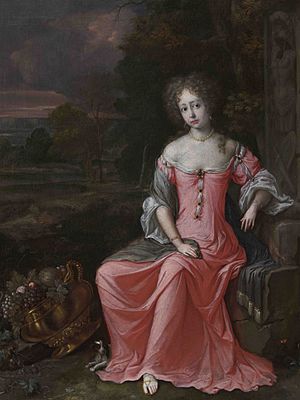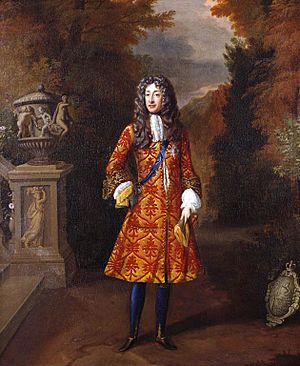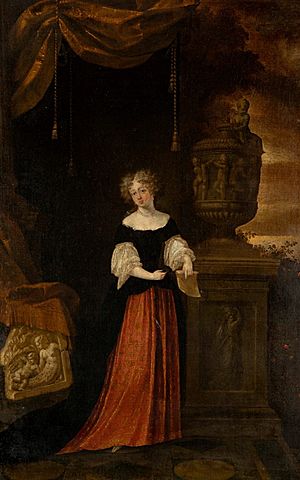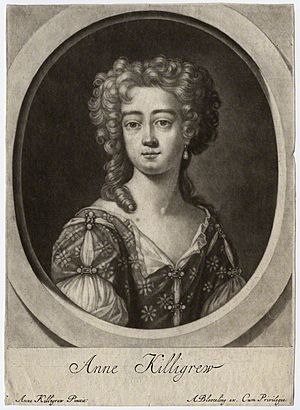Anne Killigrew facts for kids
Quick facts for kids
Anne Killigrew
|
|
|---|---|

Anne Killigrew, self portrait
|
|
| Born | 1660 St Martin's Lane, London, England |
| Died | 16 June 1685 (aged 24–25) London, England |
| Occupation | Poet |
| Nationality | British |
Anne Killigrew (1660–1685) was an English poet and painter, described by contemporaries as "A Grace for beauty, and a Muse for wit." Born in London, she and her family were active in literary and court circles. Killigrew's poems were circulated in manuscript and collected and published posthumously in 1686 after she died from smallpox at age 25. They have been reprinted several times by modern scholars, most recently and thoroughly by Margaret J. M. Ezell.
Killigrew was eulogized by John Dryden in his poem To The Pious Memory of the Accomplish'd Young Lady Mrs. Anne Killigrew (1686). Dryden praised her accomplishments in both Poësie, and Painting, and compared her poetic abilities to the famous Greek woman poet of antiquity, Sappho. Dryden's poem has received extensive critical analysis and a wide range of interpretations.
Several paintings attributed to Killigrew are known. These include a self-portrait in Berkeley Castle, and a portrait of James II of England in the Royal Collection (in 2019 on display in Hillsborough Castle). Both of these are about half life-size but full-length.

Contents
Early life and inspiration
Anne Killigrew was born in early 1660, before the Restoration, at St Martin's Lane in London. Her mother Judith Killigrew was a talented musician who played the lute and read Shakespeare. Her father Dr. Henry Killigrew published several sermons and poems as well as a play called The Conspiracy. Her two paternal uncles were also published playwrights. Sir William Killigrew (1606–1695) published two collections of plays. Thomas Killigrew (1612–1683) not only wrote plays but held a royal patent for the King's Company, and built the theatre now known as Drury Lane.
Her family, including her uncles William and Thomas, had close connections with the Stuart Court, serving Charles I, Charles II, and his Queen, Catherine of Braganza. Her grandfather, Robert Killigrew, was knighted by King James I in 1603, and appointed Vice-Chamberlain to Queen Henrietta Maria in 1630. Her father Henry Killigrew was a chaplain to Charles I, and chaplain and almoner to James, Duke of York (the future James II). Following the Restoration, Henry Killigrew became Master of the Savoy.
One of her aunts, also named Anne Killigrew (1607-1641), was appointed Lady-in-waiting to Queen Henrietta Maria beginning in 1631 and Dresser to the Queen beginning in April 1637. Another aunt, Elizabeth Boyle, served as a Lady-in-waiting to Queen Henrietta Maria, and bore an illegitimate daughter to Charles I as of 1651, while he was still in exile. Anne Killigrew's mother, Judith Killigrew, was a lady-in-waiting to Charles II's queen Catherine of Braganza. The younger Anne Killigrew is listed as one of six Maids of Honour to Mary of Modena, Duchess of York, as of 1683.
Anne had two older sisters, Mary and Elizabeth, both of whom married outside of court circles. Their father, Henry Killigrew, held the living at Wheathampstead, Hertfordshire beginning in 1663. On 14 August 1665 Mary married Nicholas Only, a clerk at Wheathampstead. On 8 May 1673 Elizabeth married the Reverend John Lambe, who took up the position of rector at Wheathampstead, Henry Killigrew having resigned from the post. Anne also had two brothers: Henry Killigrew (1652-1712) and James Killigrew (1664-1695). Both joined the Royal Navy and held positions of responsibility. Henry rose to the rank of Admiral and became a member of the Board of Admiralty.
Little is recorded about Anne's education, but she received instruction in both poetry and painting and was encouraged to pursue her creative talents, options unusual for women in the 17th century. Themes and details of her poetry and painting indicate that she was well versed in the Bible, Roman and Greek mythology, and philosophy.
Inspiration for Killigrew's poetry came as well as from other female poets who lived during the Restoration period: Katherine Philips and Anne Finch (also a maid to Mary of Modena at the same time as Killigrew). Mary of Modena encouraged the French tradition of precieuses (patrician women intellectuals) and supported women's participation in theater, literature, and music. Residing at court, Killigrew was part of a milieu of poetic feminist inspiration on a daily basis; she was a companion of strong intelligent women who encouraged her writing career as much as their own.
It was not unusual for poets, especially for women, not to see their work published in their lifetime. Before her death Anne Killigrew's poems were circulated in manuscript through selected networks of "social authorship", in which participants were often identified by pennames. Some of Killigrew's poems, like "To my Lord Colrane", were complimentary verses written according to "conventions of compliment and courtly exchange". Since Killigrew died at the young age of 25 she was only able to produce a small corpus of poetry. Compared to Philips, Finch, and others, Killigrew was an early and developing writer. Her contemporaries had many more years to develop their voices and to refine and polish their works.
Soon after Killigrew's death, a short book of thirty-three poems was published by her father as a memorial. It was suggested in the text that the last three poems might simply have been found among her papers, and not written by her. Others have argued that they are stylistically consistent with her works. Before 2009, none of her poems were known to exist in manuscript form; then a small number were found among the papers of the John Evelyn family at the British Library.
The Poet and the Painter
Anne Killigrew excelled in multiple media, which was noted by contemporary poet, mentor, and family friend, John Dryden in his dedicatory ode to her. He addresses her as "the Accomplisht Young LADY Mrs Anne Killigrew, Excellent in the two Sister-Arts of Poësie, and Painting." Indeed, Dryden uses Killigrew's accomplishments in the two sister arts as a major organizing feature of his Ode.
Scholars believe that Killigrew painted a total of 15 paintings. Both her poems and her paintings emphasize women and nature, and many of her paintings display biblical and mythological imagery. Several of her poems reference her own paintings, including "St. John Baptist Painted by her self in the Wilderness, with Angels appearing to him, and with a Lamb by him", "HERODIAS Daughter presenting to her Mother St. JOHN's Head in a Charger, also Painted by her self", and "On a Picture Painted by her self, representing two Nimphs of DIANA's, one in a posture to Hunt, the other Batheing." A list of paintings, published for Admiral Killigrew's Sale in 1727, included "Venus and Adonis"; "Satyr Playing the Pipe"; "Judith and Holiferness"; "A Woman's Head"; and "Venus attired by the Graces".
Killigrew was skilled at portraits. James Winn has suggested that the faces of the Graces in "Venus attired by the Graces" resemble those in portraits known to be of Anne Finch, Mary of Modena and Anne Killigrew. Today, as few as four of her paintings are known to exist. They include a self-portrait and a portrait of James, Duke of York.
Authorship question
In the 1686 edition of Killigrew's Poems, the last three poems are proceeded by a note: "These Three following ODES being found among Mrs Killigrews Papers, I was willing to Print though none of hers." The poems in question are:
- Cloris Charmes, Dissolved by EUDORA.
- Upon a Little Lady Under the Discipline of an Excellent Person.
- On the Soft and Gentle Motions of Eudora.
Some have argued that these three poems are stylistically consistent with Killigrew's other works. However, as Carol Barash states, "there is no archival evidence to establish who actually wrote them."
An early death
Killigrew died of smallpox in 1685, when she was only 25 years old. She was buried in the chancel of the Savoy Chapel (dedicated to St John the Baptist) on 15 June 1685. A monument was built in her honour but later destroyed by a fire. Her mother, Judith Killigrew, was also buried there, as of 2 February 1683.
Writing
Poems
- Alexandreis
- To the Queen
- A Pastoral Dialogue
- On Death
- Upon Being Contented with a Little
- On Billinda
- On an Atheist
- On Galla
- A Farewell to Worldly Joys
- The Complaint of a Lover
- Love, the Soul of Poetry
- To my Lady Berkeley
- St. John the Baptist
- Herodias
- Nimphs of Diana's
- An Invective against Gold
- The Miseries of Man
- Verses
- Queen Katherine
- My Lord Colrane
- The Discontent
- A Pastoral Dialogue
- A Pastoral Dialogue
- On my Aunt Mrs. A. K.
- On a Young Lady
- On the Duchess of Grafton
- Penelope to Ulysses
- An Epitaph on Herself
- An Ode
- Young Gallant
- Cloris Charmes
- Upon a Little Lady
- Motions of Eudora



